The Ultimate Guide to Buying a Reliable Car for Less Than $5k
We just bought a “new” used Prius for $3,250. It has high miles, but is in mint condition. We grabbed the car the day it popped up on Craigslist. Sometimes it’s hard to remember everything to check in the heat of a transaction, so I decided to create this used car inspection checklist and buying guide.
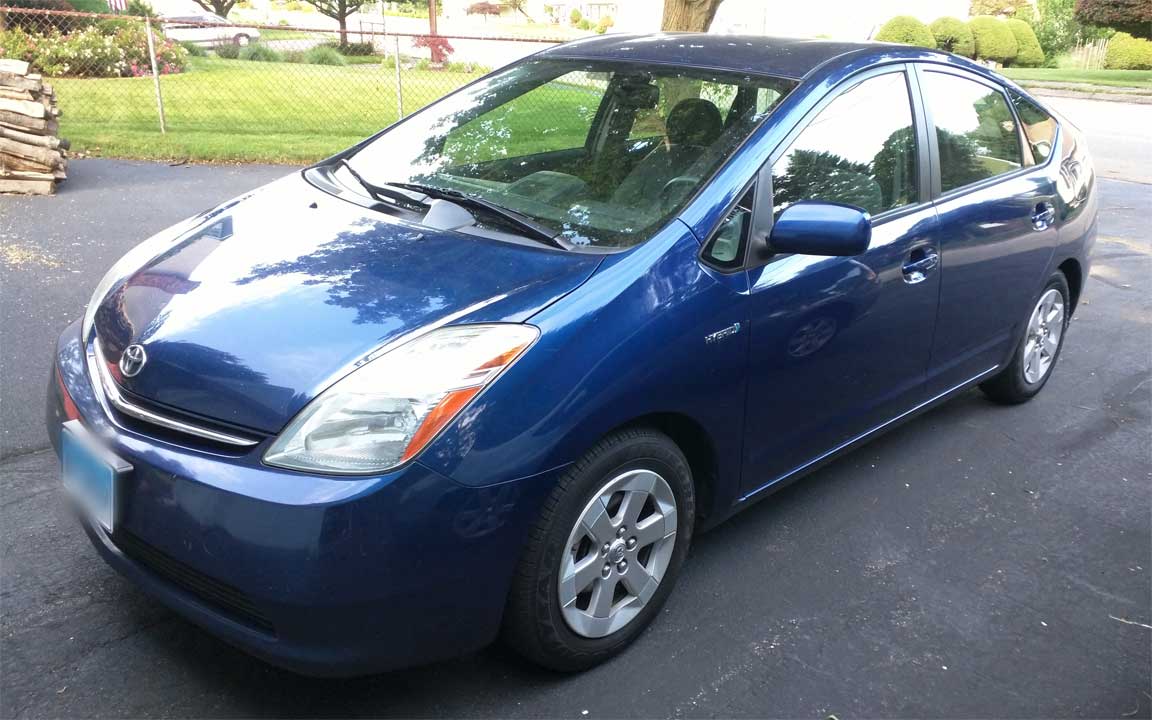 Our new $3k Prius, Bluebutt.
Our new $3k Prius, Bluebutt.
Our new car
The car we bought is a 2008 Toyota Prius with 200k miles. I honestly wasn’t expecting to get one with so many miles, but it’s in better condition than most lower mile cars. It’s almost flawless cosmetically, pulls strong, and handles better than our other Prius. I only made an offer because it passed my self inspection with flying colors. I’m confident it will be reliable for many more miles.
Selecting a frugal car
When selecting a car, I consider capacity, gas mileage, reliability, and maintenance costs. Personally, I’ve had the best luck with Hondas and Toyotas. They’re not only reliable, but parts are cheap and available everywhere. So even when you do need work done, it’s not going to be expensive.
I avoid cars that have all-wheel drive, turbos, or customization. These are all indicators of added complexity and new sources of failures. We live in New England and neither of us have ever gotten stuck in snow. A light front wheel drive car with all season tires can get through almost anything.
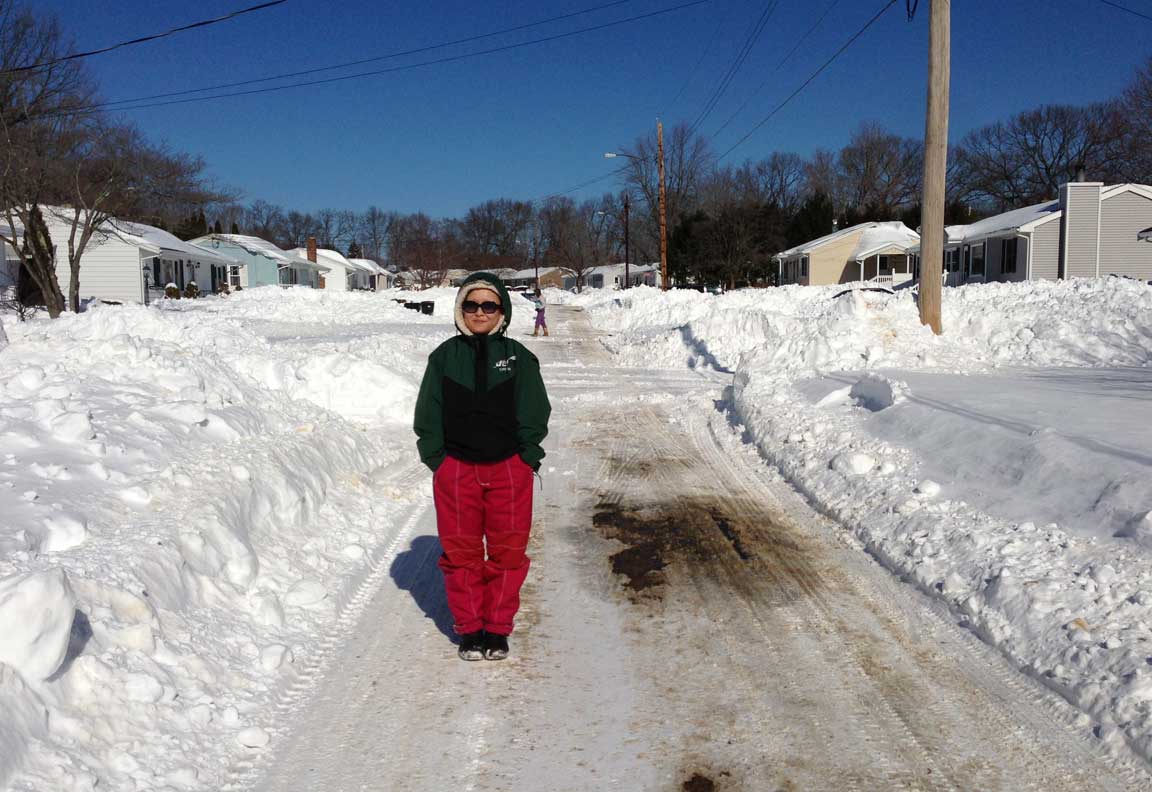 )We’ve never needed a 4X4, even with New England winters.
)We’ve never needed a 4X4, even with New England winters.
Consider a hatchback if you need lots of capacity. Using only our small hatchbacks, I’ve renovated, and maintain more than one property. I’ve hauled kegerators, dishwashers, doors, trees, lumber, and enough firewood to heat our entire home all winter. I’ve even picked up mattresses, 6’x8′ fencing sections, kayaks, and 12ft rolls of vinyl flooring using my roof rack. In over 10 years of home ownership, I’ve only needed a truck a handful of times, and when I did, I was able to rent one for about $40 bucks.
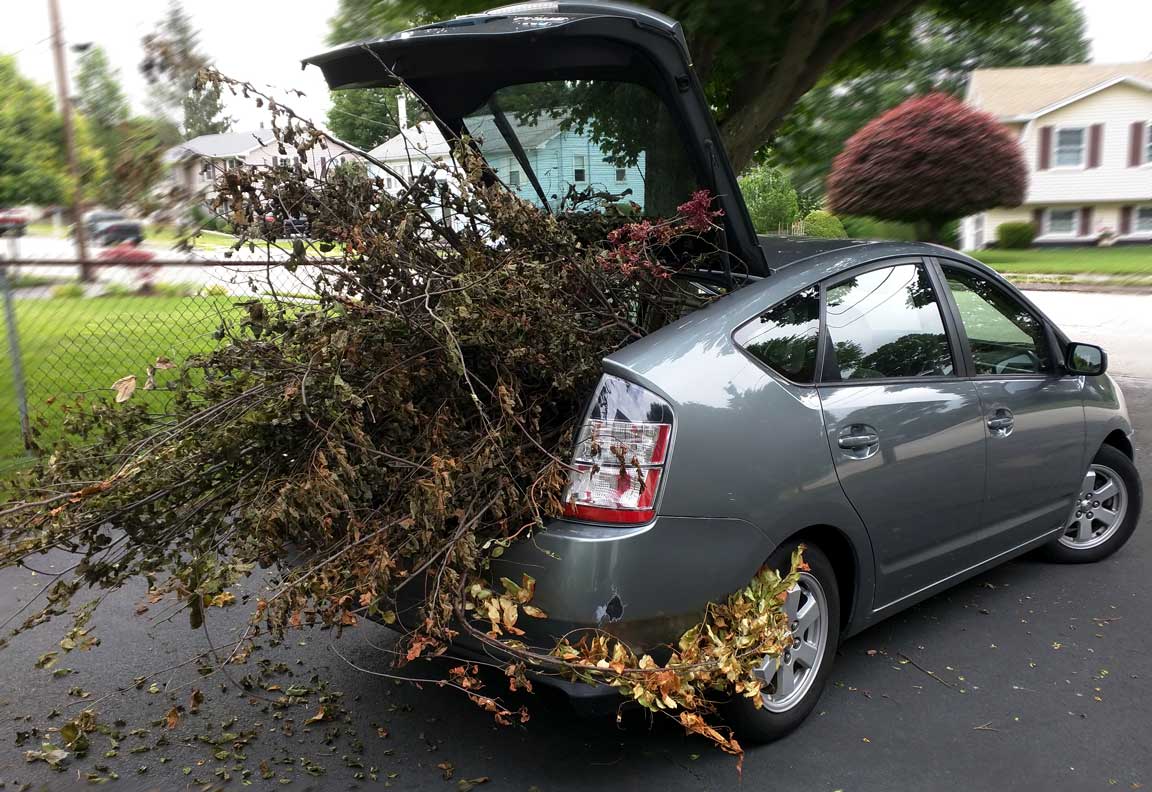 I rarely need a pickup to maintain our homes.
I rarely need a pickup to maintain our homes.
Right now my favorite car is the Toyota Prius. We bought our first used Prius, Lightning, for $5,000 and put on 45,000 trouble-free miles. It averages 45 MPG for us – double what our old car got – and we’ve saved about 1,000 gallons of gas. That’s approximately $2,500 in savings, even with the low gas prices we’ve been having. If our new Prius makes it 50,000 miles, it will pay for itself in gas savings alone.
Get to know the car you want
Before we bought our first Prius, we went to a dealer and test drove new and used models. This gave me an idea of how it should accelerate, brake, handle, and sound when under load or idle. Even if the Prius isn’t the car for you, I suggest choosing a model and getting to know it.
I also researched major maintenance costs. If the hybrid battery goes, I will probably try to repair it myself, but I’ve also seen Craigslist ads for hybrid battery repair for $300-$500. Other typical maintenance costs like replacing a water pump or changing spark plugs are around $200 at the dealer.
While I can do a lot of the repair work myself, I prefer not to, and the Prius is ranked #1 in reliability. Several mechanics have told us the only thing that car ever needs are oil changes, and I’ve seen some for sale with 250-300k miles. This gave me the confidence to buy one with 200k miles on it.
Start hunting
Once you’ve done your research, and know the car you want, start searching Craigslist and the classifieds. I always look for deals from individuals and not dealers – there is a big difference between private party and retail prices for used cars. Also, take your time, good deals seldom pop up, and you need patience to get them. Just make sure you’re ready to pounce when the right car does come along.
To gauge a deal, I compare prices with private party blue book values on kbb.com. The blue book private party sale price for our car ranged from $2,700 for fair condition to $3,900 for excellent condition. This gave me a range that I would be comfortable offering.
How I self inspect cars
To get a good deal, I like to be ready to make a cash offer on the spot, but I always inspect the car thoroughly before talking any numbers. This includes a parking lot inspection as well as a driving inspection.
Questions for the owner
Before I even see the car, I like to ask the owner a few questions. This is a chance to establish rapport and get an idea of what kind of owner the person is. Often times sellers offer up additional information. Here are some questions I tend to ask:
- Are you the original owner?
- Has the car ever been in an accident?
- Is the title clean?
- How often did you change the oil?
- Did you do the scheduled maintenance like changing spark plugs?
- Did you keep the car in a garage or outside?
- Is the emissions inspection current?
Parking lot inspection checklist
When I meet up with the seller, I’ll start with a parked inspection. As with the questioning, sometimes a seller will offer up information you didn’t expect when you start poking around the car.
- Dashboard – Exercise every switch.
- Door locks
- Window controls
- Mirror controls
- Head lights
- Break lights
- A/C
- Heat
- Wipers
- Turn signals
- Radio
- Backup Camera or any other additional features
- Trunk lid opener
- Gas door opener
- Body – Look for dents, dings, and especially rust. Rust usually occurs where water sits in wheel wells or edges of doors. Often, rust only looks like a bubble in the paint.
- Paint – If the owner kept the car in a garage and waxed it regularly, the paint will be bright and shiny. If it was outside and neglected, it will be dull and hazy.
- Windows – Check for any cracks or chips. Sometimes the tiny ones can be repaired for a few dollars with epoxy. (affiliate link)
- Tires – Feel the tread depth with your fingers. If the tread is less than 1/8th of an inch deep, you will need new tires soon. Make sure to check all 4.
- Interior – Inspect for holes, burns, or worn out sections of upholstery. Check if the padding on the driver seat feels worn, if the carpet is stained, or if the ceiling fabric is drooping.
- CV boots – If you turn the font wheels on the car, you will see a rubber boot where the axle goes into the wheel. Just make sure this isn’t torn, or you will need new CV boots.
- Engine bay – Check that oil and coolant levels are good. Low levels could mean the car is burning them off or leaking. Check under oil cap, a buildup of white gunk could mean bad head gasket.
- Startup – Watch exhaust for excessive black or white smoke. Black smoke could mean its burning oil, white smoke could mean bad head gasket.
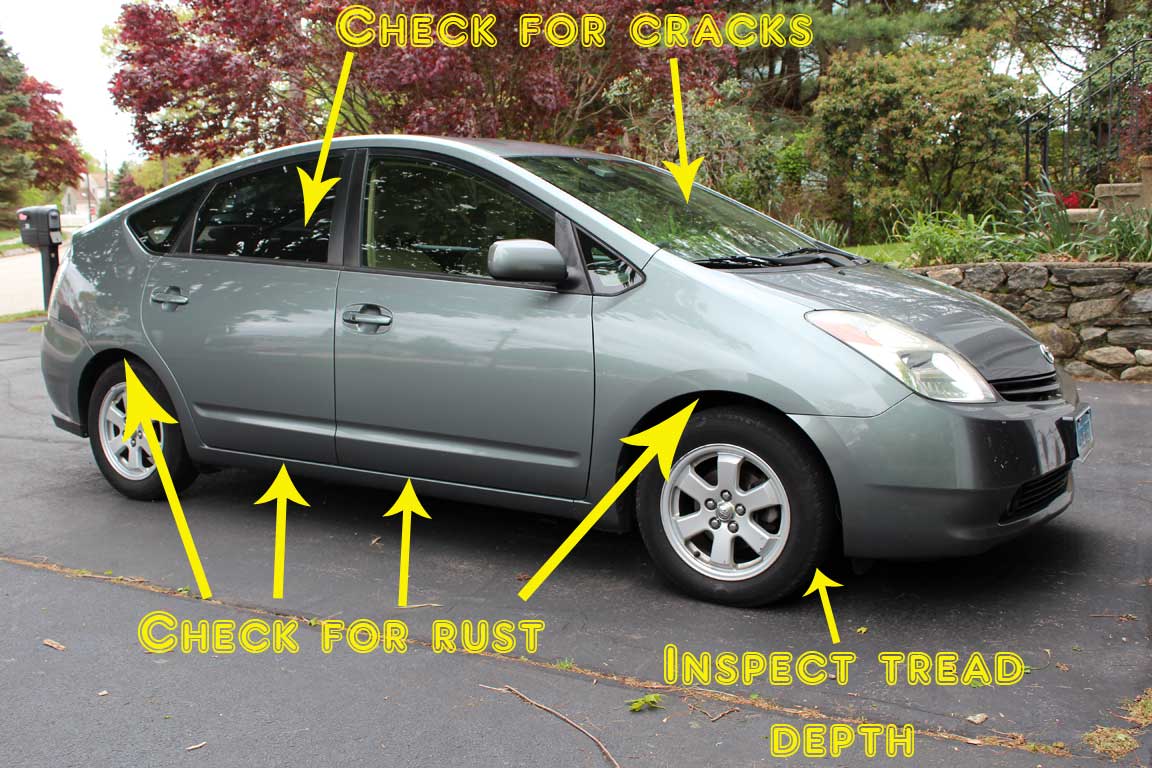
Driving Inspection
If possible, get the car on the highway and up to higher speeds. You don’t need to drive like an idiot, but you do want to exercise the brakes, and see how the car accelerates. Often times, vibrations only come out at higher speeds.
- Acceleration – Does the car feel as strong as the others you tested? Does the engine get louder than expected when accelerating? These could mean engine or exhaust issues.
- At highway speed – If the car consistently pulls to one side, it probably needs an alignment.
- Braking – If the car shakes at speed or when braking, it might need new rotors. If you hear squealing, it probably needs new brakes.
- Handling – If the car feels like it’s swaying too much in a turn or is wallowing after going over a bump, it probably needs new shocks and springs.
- Cruise control – Does it turn on and function properly?
- Turns – If the car vibrates in turns, it might need new wheel bearings or CV axle.
- Checking automatic transmission – Check forward and reverse. Does the car hesitate or jump when starting or going through gears?
- Checking manual transmission – Exercise all gears. Is there grinding going in or out of any gears? Put the car in a higher gear, then punch the gas. If the engine winds up, but the car doesn’t accelerate much, you’ll need a new clutch.
- Check engine light – Is it lit? Depending on the code, this could mean a slew of expensive repairs like a new hybrid battery or catalytic converter.
How to do a free VIN check
Title information is tracked by the government in the “National Motor Vehicle Title Information System” database. There are several sites like Carfax that will charge you for access to the information. But I found one that gives free reports.
Even if you don’t check online, a title that isn’t clean will probably have a branding in big letters on it. For example our first Prius is a rebuilt car, and the title has “REBUILT” in large bold print on the front of it. Just make sure the title matches the VIN on the car!
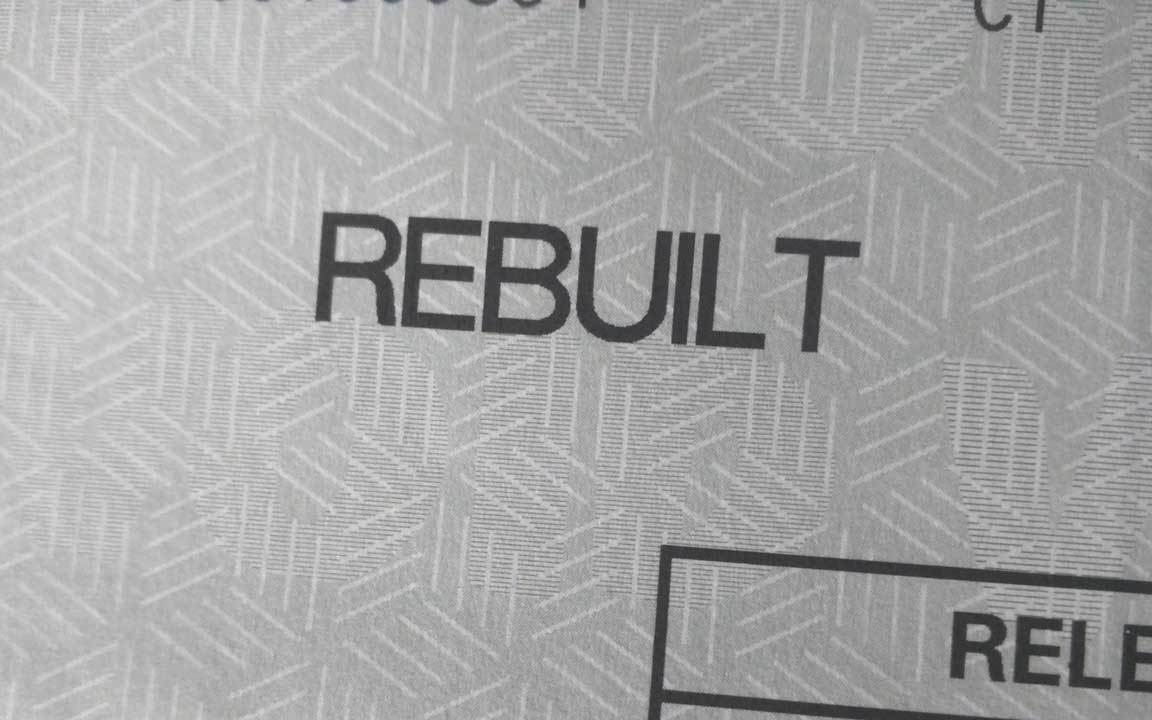 A branded title should be obvious.
A branded title should be obvious.
Make an offer
By this point, I have an idea if I want to make an offer, and what grade I consider the car. If there are any mechanical issues, I’ll only make an offer if I’m confident that I know what needs to be fixed, and how much it will cost. Otherwise, I’ll use cosmetic defects like dents to justify a lower offer.
For our Prius, I couldn’t really find any issues except a missing side mirror cover. The guy was asking $3,800, which was about the price I would expect for that car in very good condition, which it was. But I wasn’t thrilled about the high mileage, so I made a lower offer of $3,000 cash. If you’ve tried selling a car, you know an on the spot cash offer is very tempting. We settled on $3,250 and got a new mirror cover from the dealer for $42.
Don’t get stuck with a car payment
I once bought a sporty new car, and ended up selling it a few years later at a loss. Swapping it out for a cheap used car was one of the best financial decisions I’ve made. I calculated that dropping those car payments and investing the money instead made me $70k wealthier allowing me to retire early a few years later.
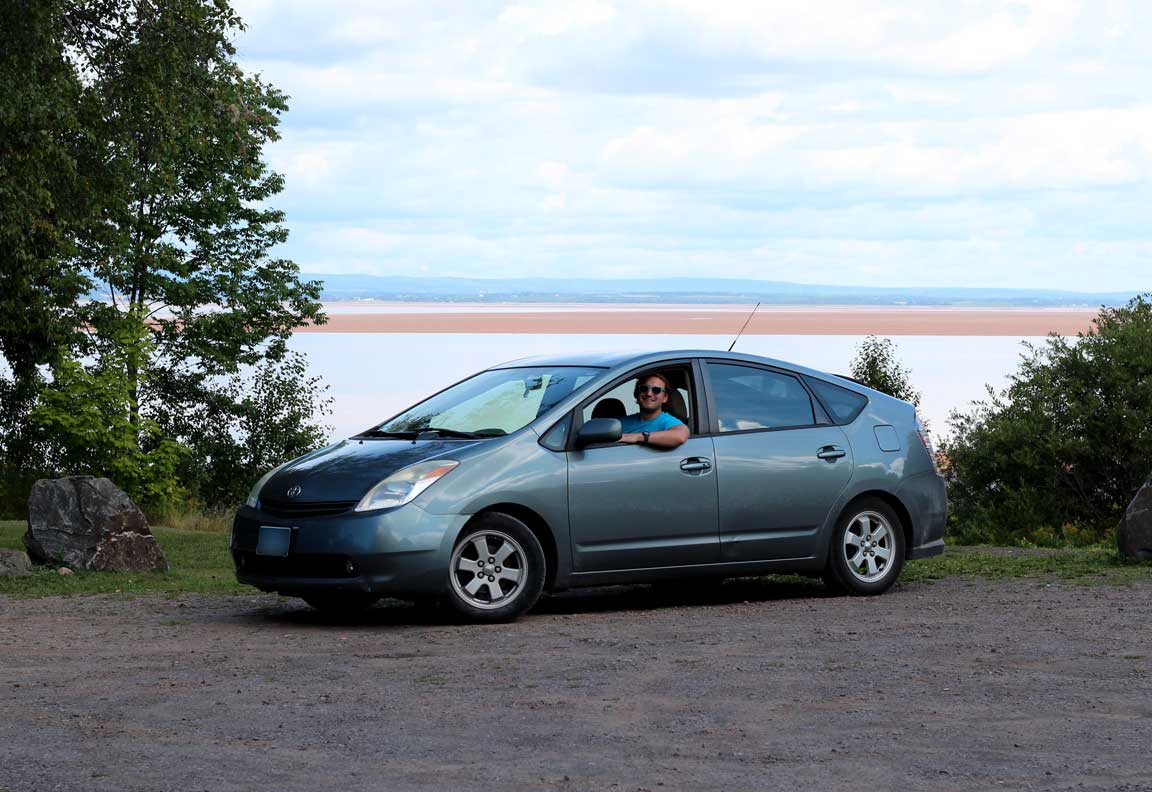 Our old Prius, Lightning, at the Bay of Fundy.
Our old Prius, Lightning, at the Bay of Fundy.
These days, our cars range in price from $3k-$5k. After doing my basic self inspections, I’ve never had a major issue pop up after buying. Our cars have never broken down, and we only need to carry liability coverage because we could just buy another car for $3k. This means hundreds of dollars in insurance premium savings every year.
In the end, we gave our old Prius Lightning to my mother-in-law because she wasn’t fond of blue. We couldn’t have been happier to trade her, because the new blue Prius came with a backup camera and JBL sound system. We decided to name it Bluebutt, and it’s probably the coolest and cheapest car we’ve had. It will likely pay for itself in gas savings alone, and if a tree falls on it, I’ll still sleep fine at night.